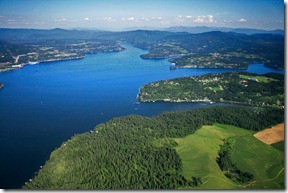I was looking forward to stopping along the shores of Lake Coeur d’Alene in northern Idaho with my daughter and two grandsons last month during our annual migration to visit family at another lake a few miles away on the Idaho-Washington border.
This was my daughter’s idea. She knows there is family heritage there, mostly gleaned from old photos and glints of pre-school memory. My parents had a home along the shores of Windy Bay which is formed by an elbow in the lake and where I docked a nifty Neptune 16 sailboat. Prior to building their own her grandparents rented a cabin for a couple of weeks each summer while they explored various part of the lake.
After stopping for burgers at the iconic, counter-only 105-year-old Hudson’s, which is deliciously famous for its minimalist menu, we strolled a block along the public beach to Independence Point and took a seaplane excursion aboard a Brooks de Havilland Beaver around the huge lake which brought back a flood of memories.
First flown in 1948, the year I was born, Beavers were a common site and experience during my stint in Anchorage, Alaska where the Lake Hood Seaplane Base, the largest in the world, rests along side the Anchorage International Airport on a peninsula jutting out into Cook Inlet from the Chugach Range, mid way across town.
If you haven’t flown in a Beaver, click here to see and hear a take-off and click here to see the view a news crew took with Brooks a few days after our flight.
As we flew above Lake Coeur d’Alene that day(photo in this blog courtesy of 29k Productions) on our way to where Windy Bay forms an elbow, I was listening to the crackle in the earphones as the pilot pointed out the homes of famous people along the way such as Dennis Franzen, Wayne Gretsky, John Elway and many more, but my eyes were on the hilltops that dot the shores of the lake.
Most had been denuded of all trees, which are a signature reason why people have long chosen to settle along the lake, in preparation for planned communities including golf courses while facilitating erosion and run off into the lake below.
Such devastation is needless. Developers used to carefully preserve trees which add property value and so much more, but few do now. It is another example of what economists call externalities of the marketplace, where, in this case, negative costs and ramifications from this massive amount of clear-cutting are passed to others who aren’t even involved while the individuals or companies responsible reap all of the profits.
For me, it just scarred a once pristine memory.
No comments:
Post a Comment